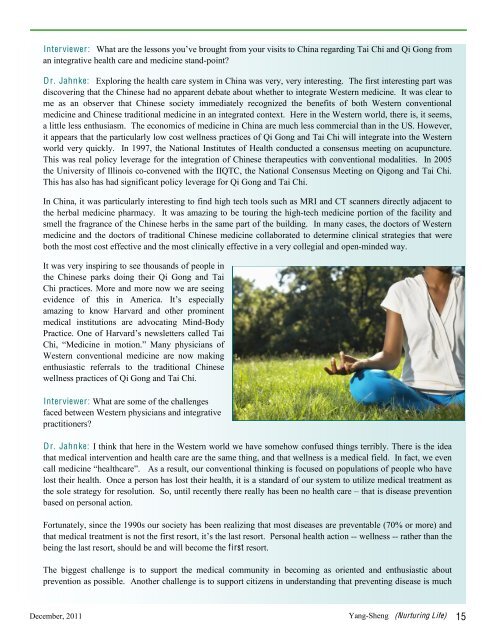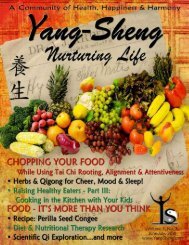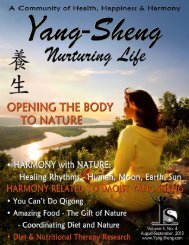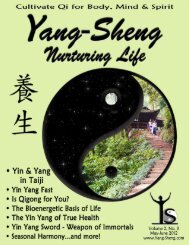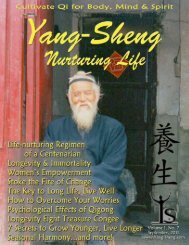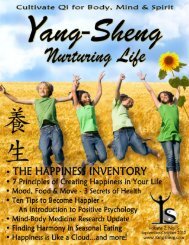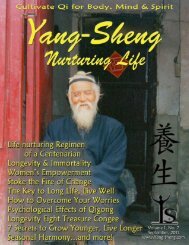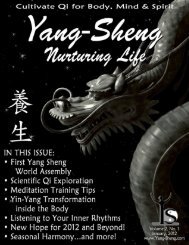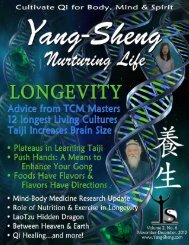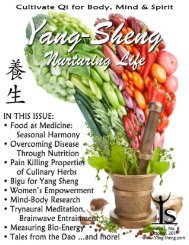Download the December issue of Yang-Sheng as
Download the December issue of Yang-Sheng as
Download the December issue of Yang-Sheng as
You also want an ePaper? Increase the reach of your titles
YUMPU automatically turns print PDFs into web optimized ePapers that Google loves.
Interviewer: What are <strong>the</strong> lessons you’ve brought from your visits to China regarding Tai Chi and Qi Gong from<br />
an integrative health care and medicine stand-point?<br />
Dr. Jahnke: Exploring <strong>the</strong> health care system in China w<strong>as</strong> very, very interesting. The first interesting part w<strong>as</strong><br />
discovering that <strong>the</strong> Chinese had no apparent debate about whe<strong>the</strong>r to integrate Western medicine. It w<strong>as</strong> clear to<br />
me <strong>as</strong> an observer that Chinese society immediately recognized <strong>the</strong> benefits <strong>of</strong> both Western conventional<br />
medicine and Chinese traditional medicine in an integrated context. Here in <strong>the</strong> Western world, <strong>the</strong>re is, it seems,<br />
a little less enthusi<strong>as</strong>m. The economics <strong>of</strong> medicine in China are much less commercial than in <strong>the</strong> US. However,<br />
it appears that <strong>the</strong> particularly low cost wellness practices <strong>of</strong> Qi Gong and Tai Chi will integrate into <strong>the</strong> Western<br />
world very quickly. In 1997, <strong>the</strong> National Institutes <strong>of</strong> Health conducted a consensus meeting on acupuncture.<br />
This w<strong>as</strong> real policy leverage for <strong>the</strong> integration <strong>of</strong> Chinese <strong>the</strong>rapeutics with conventional modalities. In 2005<br />
<strong>the</strong> University <strong>of</strong> Illinois co-convened with <strong>the</strong> IIQTC, <strong>the</strong> National Consensus Meeting on Qigong and Tai Chi.<br />
This h<strong>as</strong> also h<strong>as</strong> had significant policy leverage for Qi Gong and Tai Chi.<br />
In China, it w<strong>as</strong> particularly interesting to find high tech tools such <strong>as</strong> MRI and CT scanners directly adjacent to<br />
<strong>the</strong> herbal medicine pharmacy. It w<strong>as</strong> amazing to be touring <strong>the</strong> high-tech medicine portion <strong>of</strong> <strong>the</strong> facility and<br />
smell <strong>the</strong> fragrance <strong>of</strong> <strong>the</strong> Chinese herbs in <strong>the</strong> same part <strong>of</strong> <strong>the</strong> building. In many c<strong>as</strong>es, <strong>the</strong> doctors <strong>of</strong> Western<br />
medicine and <strong>the</strong> doctors <strong>of</strong> traditional Chinese medicine collaborated to determine clinical strategies that were<br />
both <strong>the</strong> most cost effective and <strong>the</strong> most clinically effective in a very collegial and open-minded way.<br />
It w<strong>as</strong> very inspiring to see thousands <strong>of</strong> people in<br />
<strong>the</strong> Chinese parks doing <strong>the</strong>ir Qi Gong and Tai<br />
Chi practices. More and more now we are seeing<br />
evidence <strong>of</strong> this in America. It’s especially<br />
amazing to know Harvard and o<strong>the</strong>r prominent<br />
medical institutions are advocating Mind-Body<br />
Practice. One <strong>of</strong> Harvard’s newsletters called Tai<br />
Chi, “Medicine in motion.” Many physicians <strong>of</strong><br />
Western conventional medicine are now making<br />
enthusi<strong>as</strong>tic referrals to <strong>the</strong> traditional Chinese<br />
wellness practices <strong>of</strong> Qi Gong and Tai Chi.<br />
Interviewer: What are some <strong>of</strong> <strong>the</strong> challenges<br />
faced between Western physicians and integrative<br />
practitioners?<br />
Dr. Jahnke: I think that here in <strong>the</strong> Western world we have somehow confused things terribly. There is <strong>the</strong> idea<br />
that medical intervention and health care are <strong>the</strong> same thing, and that wellness is a medical field. In fact, we even<br />
call medicine “healthcare”. As a result, our conventional thinking is focused on populations <strong>of</strong> people who have<br />
lost <strong>the</strong>ir health. Once a person h<strong>as</strong> lost <strong>the</strong>ir health, it is a standard <strong>of</strong> our system to utilize medical treatment <strong>as</strong><br />
<strong>the</strong> sole strategy for resolution. So, until recently <strong>the</strong>re really h<strong>as</strong> been no health care – that is dise<strong>as</strong>e prevention<br />
b<strong>as</strong>ed on personal action.<br />
Fortunately, since <strong>the</strong> 1990s our society h<strong>as</strong> been realizing that most dise<strong>as</strong>es are preventable (70% or more) and<br />
that medical treatment is not <strong>the</strong> first resort, it’s <strong>the</strong> l<strong>as</strong>t resort. Personal health action -- wellness -- ra<strong>the</strong>r than <strong>the</strong><br />
being <strong>the</strong> l<strong>as</strong>t resort, should be and will become <strong>the</strong> first resort.<br />
The biggest challenge is to support <strong>the</strong> medical community in becoming <strong>as</strong> oriented and enthusi<strong>as</strong>tic about<br />
prevention <strong>as</strong> possible. Ano<strong>the</strong>r challenge is to support citizens in understanding that preventing dise<strong>as</strong>e is much<br />
<strong>December</strong>, 2011 <strong>Yang</strong>-<strong>Sheng</strong> (Nurturing Life) 15


